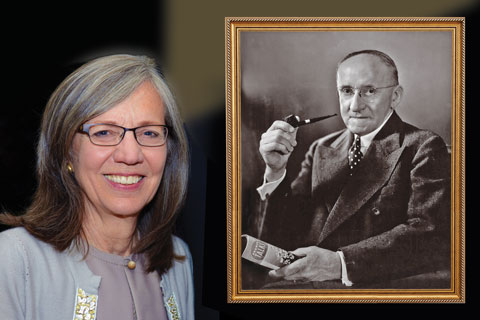8/1/2020
Celebrating the 1,000th Issue of GrowerTalks
Anna Ball

Everyone in my family seems to love to write. It started with my grandfather, George J. Ball. He began as a cut flower grower, growing calendulas, sweet peas and snapdragons for the Chicago market.
Growing was, of course, his main job, but his hobby—or should I say second job?—was writing. He faithfully kept a daily journal for 50 years! Can you imagine? He began his journals as a young soldier fighting in Cuba and the Philippines during the Spanish American War in 1898, documenting his many harrowing and horrific experiences. He continued his journals up until his death in 1949.
His favorite topics were improved growing techniques, innovations in the industry and his travels. In 1936, he wrote an article on the timing of sweet peas for the main grower publication at the time, Florist Review. But he was quite upset when they didn’t publish the article in time for the growers to take advantage of his advice. After all, he’d been an advertiser since 1903! His response was to start his own magazine: Grower Talks*. His wife, Anna Kruse, was an English teacher and a prolific writer. She served as proofreader and editor. I’m sure this wasn’t an easy job, as he tended to go on and on ...
Even before Grower Talks he tried his hand at book writing. In 1923, he decided to consolidate the information he’d collected on sweet pea culture and share it with the industry. He called that first book “Better Sweet Peas.” I remember seeing it around the house as a child and wondering how on earth a whole book could be written about one crop! He went on to write other floriculture books, including the famous Ball Red Book, which is in its 18th edition and still popular.
Grandfather’s philosophy was very clear. He believed all information should be shared with everyone—quickly and openly. At that time, the cut flower industry was very young, so everything growers learned through trial and error was new knowledge. It was an incredible time of growth and discovery. If the industry was to continue to grow and develop, he thought, then everyone needed to share whatever they could learn about how to grow, harvest and ship cut flowers. He had no use for anyone who kept information to themselves. As he saw it, everyone stood to benefit if all the information was shared. That was the basis for Grower Talks then and it remains the basis today.
Grandfather was also outspoken. He wrote a lot about politics, the war, other countries, how to price and market—you name it, he had an opinion on it. But his views weren’t always the most popular! In the 1930s, he became friends with Mr. T. Sakata of Japan. Mr. Sakata was a fellow flower breeder and the two wrote often, shared seed and advice, and visited each other throughout the 1930s. So when WW II broke out and the Japanese people living in America were sent off to detention camps, grandfather would not stand for it. He stepped in to protect a Japanese family living here in West Chicago, gladly supplying them with housing and jobs at the company during the war. Not exactly a popular course of action in WWII America.
Being transparent and not afraid of controversy is important if you want to be a good writer. His descriptions of the conditions of the soldiers in Cuba and the Philippines were frank, descriptive and didn’t cling to the “party line.” His outspoken views on pricing and many other aspects of floriculture always created a stir.
Compared to many other industries I’m familiar with, we’re by far the most open. I have friends who work in the food, retail and banking industries. They’re all amazed when I tell them that almost every grower in the world will let you come and tour their greenhouse or fields, and will be open and free with information about what they’re growing and selling.
This is a huge strength that we have as an industry. My grandfather was president of SAF—the Society of American Florists—the only trade association at the time. Their role was also based on that same philosophy of sharing and learning together. Our openness as an industry, helped by our trade associations, has given many of us wonderful careers and allowed us to contribute so much beauty to the world.
We hope to continue GrowerTalks magazine in its many formats—both print and digital—for years to come. Let us know how we can keep improving and sharing information! GT
Anna Ball is President and CEO of Ball Horticultural Company based in West Chicago, Illinois. She can be reached at aball@ballhort.com.
*Editor’s note: At its inception, Grower Talks was two words. It didn’t become one word (with the T still capitalized) until the early 1980s when it became a full-fledged magazine.—JZ